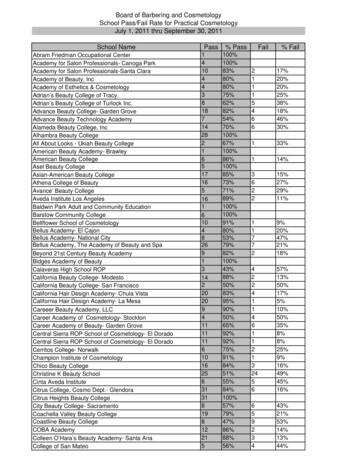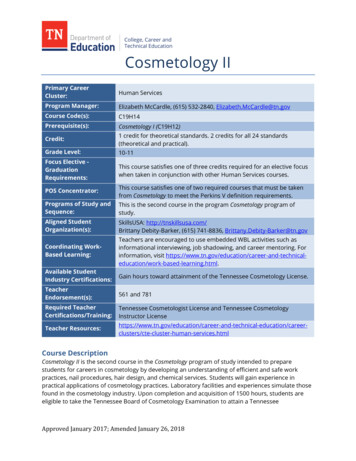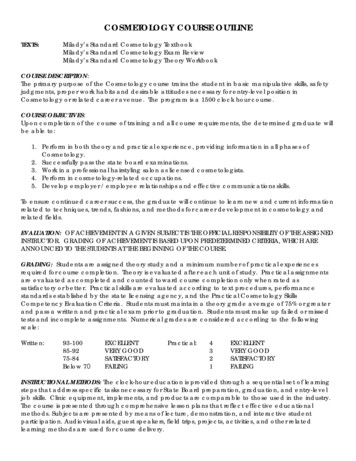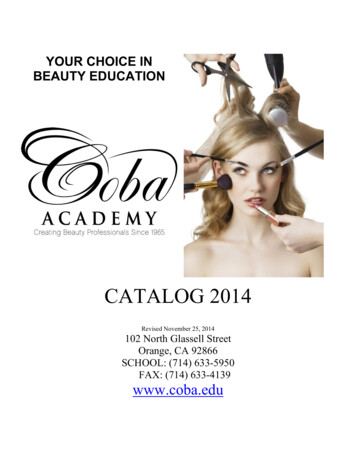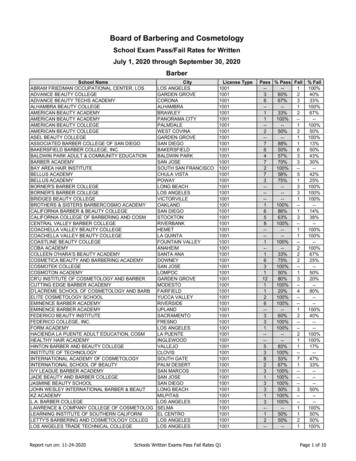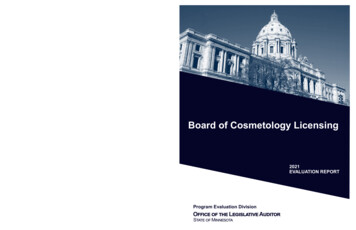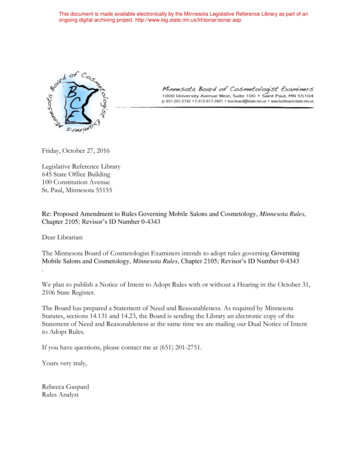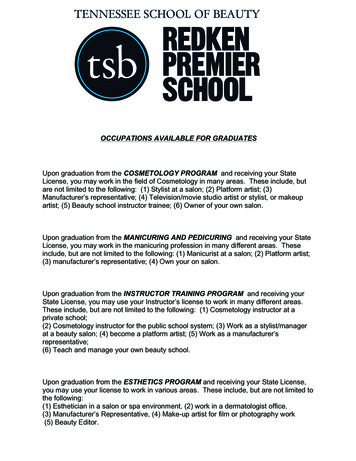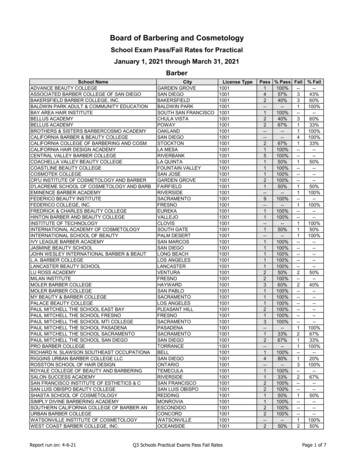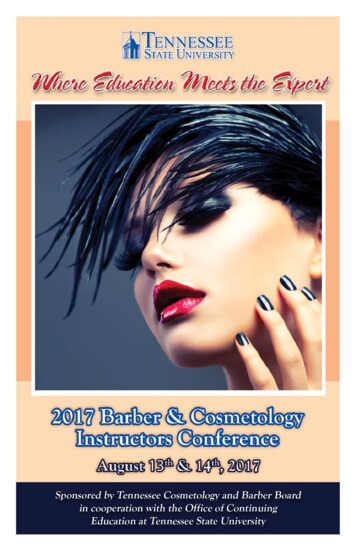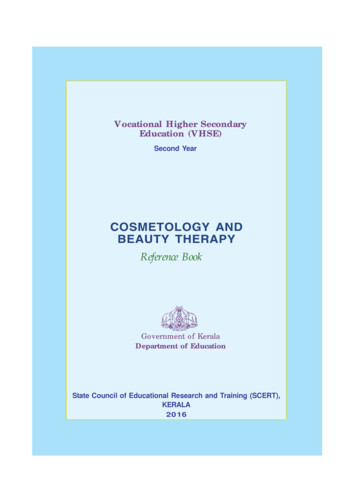
Transcription
Vocational Higher SecondaryEducation (VHSE)Second YearCOSMETOLOGY ANDBEAUTY THERAPYReference BookGovernment of KeralaDepartment of EducationState Council of Educational Research and Training (SCERT),KERALA20 16
Reference BookList of ContributorsParticipants1.2.3.4.5.6.Girija S.RVocational teacher in CBPM GVHSS(G) , ThrissurDeepa V.RVocational teacher in CBPM GVHSS (G), KottarakkaraLekshmi Devi C.SVocational teacher in CBPM GVHSS (G) ,pettah, ThiruvananthapuramBijimol MathewVocational teacher in CBPM GVHSS(G) ,Payyambalam, KannurRakhi.PVocational Instructor in CBPM GVHSS(G) ,pettah, ThiruvananthapuramVimal PraveenGHSS Mancode, PathanamthittaExperts1.Pattanam RasheedChairman, Pattanam Designory, Stadium Round Road,Jawaharlal Nehru Internation Stadium, Kaloor, Kochi2.Dr.Reema Padmakumar(Aesthetic Consultant), Karthika Nagar,KNRA - 312, Thulayil lane, Pettah. P. OAcademic Co-ordinatorDr. N. KalaResearch Officer, SCERT2
COSMETOLOGY AND BEAUTY THERAPYFOREWORDDear Learners,This book is intended to serve as a ready reference for learners of vocationalhigher secondary schools. It offers suggested guidelines for the transactionof the concepts highlighted in the course content. It is expected that thelearners achieve significant learning outcomes at the end of the course asenvisaged in the curriculum if it is followed properly.In the context of the Right- based approach, quality education has to beensured for all learners. The learner community of Vocational HigherSecondary Education in Kerala should be empowered by providing themwith the best education that strengthens their competencies to becomeinnovative entrepreneurs who contribute to the knowledge society. Thechange of course names, modular approach adopted for the organisationof course content, work-based pedagogy and the outcome focused assessmentapproach paved the way for achieving the vision of Vocational HigherSecondary Education in Kerala. The revised curriculum helps to equip thelearners with multiple skills matching technological advancements and toproduce skilled workforce for meeting the demands of the emergingindustries and service sectors with national and global orientation. Therevised curriculum attempts to enhance knowledge, skills and attitudes bygiving higher priority and space for the learners to make discussions insmall groups, and activities requiring hands-on experience.The SCERT appreciates the hard work and sincere co-operation of thecontributors of this book that includes subject experts, industrialists andthe teachers of Vocational Higher Secondary Schools. The developmentof this reference book has been a joint venture of the State Council ofEducational Research and Training (SCERT) and the Directorate ofVocational Higher Secondary Education.The SCERT welcomes constructive criticism and creative suggestions forthe improvement of the book.With regardsDr. P. A. FathimaDirector, SCERT Kerala3
Reference BookCONTENTSPart A1.About the course . 052.Major Skills (sub-skills) . 063.Syllabus - . 07Module 3, 4 (units with number of periods) . 09Part B4.Module 3 - Make up Artistry3.1 Art of Make Up. 103.2 Mehandi Designing . 373.3 Flower Arrangement and Bouquet setting . 433.4 Jewel Making . 605.Extended Activities Module 3 . 646.List of practicals Module 3 . 657.Module 4- Beauty Business Management4.1 Beauty Business . 674.2 Health and Wellness . 734.3 Personality Development . 1034.4 Beauty Entrepreneurship . 1098.Extended Activities Module 4 . 1169.List of Practicals Mdoule 4 . 11710 Reference . 1184
COSMETOLOGY AND BEAUTY THERAPYABOUT THE COURSEBeauty is a characteristic of a person, animal, place, object or idea that providesa perceptual experience of pleasure or satisfaction. Beauty is studied as part ofaesthetics, Sociology, Social Psychology and culture. An "ideal beauty" is anentity which is admired or who possesses features widely attributed to beautyin a particular culture in perfection. The experience of "beauty" often involvesan interpretation of some entity as being in balance and harmony with nature,which may lead to feelings of attraction and emotional well being because thiscan be a subjective experience. It is often said that "beauty is in the eye of thebeholder". There is evidence that perceptions of beauty are evolutionallydetermined and that things, aspects of people and landscapes considered beautifulare typically found in situations likely to give enhanced survival of the perceivinghuman's genes. Standards of beauty change over times, based on changing culturalvalues.'Beauty' means quality or feature that gives pleasure to the mind or senses, and'Therapy' refers to a healing power or quality. Taken together, the two wordsdescribe what beauty therapists are hoping to achieve. Using practical skillsand knowledge, they provide a therapeutic treatment for their clients and achieveoutcomes that will condition, and enhance facial and body conditions, relax,de- stress and improve their confidence. Beauty therapy is an art by which thetotal personality of a person can be changed in a positive and attractive way.Men and women have tried every possible way to look attractive. Now inmodern world various methods and practices have been developed to improvebeauty. Medical field also promotes beautification through cosmetic surgeries.So now the time has come to realize the quality of beauty therapy and services.Regular systematic and authentic work and researches are unavoidable in thefield of beauty therapy.5
Reference BookMAJOR SKILLS1. Skill in makeup Artistry Professional makeup skill Skill in Mehandi designing Making flowers and Bouquet Setting Jewel making2. Skill in Beauty Business Management6 Setting Beauty Parlour Diet Chart Preparation Wellness Exercises Yogasanas Personality Development
COSMETOLOGY AND BEAUTY THERAPYSyllabusModule 3: Makeup Artistry3.1 Art of Make Up(165 periods)Introduction - What is make up - History of makeup - Cosmetics usedin makeup - makeup techniques - Implements and tools for makeup Facial Anatomy-Basic facial shapes - Corrective makeup - Professionalmakeup - Qualities of a makeup artist - Make up and age tips.3.2 Mehandi Designing(55 periods)Introduction - History of Mehandi - Types of mehandi designs - Mehandicone preparation.3.3 Flower Arrangement and Bouquet setting(70 periods)Introduction - Cutting flowers and foliage - Conditioning plant materials- principles of flower arrangement - Elements of design - principles ofdesign - styles of flower arrangement - Types of flower arrangement Flower making-Bouquet setting .3.4 Jewel Making(50 periods)Introduction - Tools for jewellery making - Types of Jewellery.7
Reference BookModule 4: Beauty Business Management4.1 Beauty Business(62 periods)Introduction - Importance of Beauty business - Beauty businessmanagement - Function of beauty parlor mangers - Marketing.4.2 Health and Wellness(120 periods)Introduction - Definition and meaning - Dimensions of health andwellness - Ten recognised general physical skills - Five componentsof physical fitness - Nutrition and diet - Body composition assessment- Exercise - Yoga - History of Yoga - Asanas.4.3 Personality Development(86 periods)Introduction - Traits of personality development - Time management Motivation - Personal grooming - Stress management.4.4 Beauty Entrepreneurship(72 periods)Qualities of an entrepreneur - Scope of Entrepreneurship in beautybusiness - Women Entrepreneur - Success story - SWOT analysis inbeauty Entrepreneurship.8
COSMETOLOGY AND BEAUTY THERAPYModule IIIMake Up ArtistryPeriods:340Unit NoName of UnitsTheoryPractical's3.1Art of make up571083.2Mehandi Designing15403.3Flower Arrangement andBouquet Setting2050Jewel Making1040Total1022383.4Module IVBeauty Business ManagementPeriods:340Unit NoName of UnitsTheoryPractical's4.1Beauty business30324.2Health and Wellness30904.3Personality 022389
Reference BookMODULE 3MAKE UP ARTISTRYOverviewThis module provides an introduction to thebasics of makeup artistry and an insight into thebeauty make up industry. The student will learnthe key techniques for creating impeccablebeauty make up styles and find out what a careeras a makeup artist involves. Demonstrations willbe followed by the chance to practice on the fellow students and will coverdisuse looks that will include a natural beauty look, a day time look and asmoky eye evening look as well as false lash application. This module alsointroduces flower arrangements, bouquet setting, mehandi designing and jewelmaking.UNIT 3.1 ART OF MAKE UP3.1.1 IntroductionMake up is a technique that actually creates thelook that one wishes to project. It is not a naturaltalent, but a technique that is learnt and mastered,bringing into use one's power of observation,good taste and colour sense. The art of makeuprequires patience, knowledge, common sense,artistic mind, tolerance, knowledge about the art, ingredients and tools of makeupand a clear face.The main purpose of makeup application is to emphasize one's good facialfeatures and minimize the less attractive features.Learning outcomesThe learner10 understands and explain about makeup identifies different implements & tools used for make up understands and identifies different Facial shapes
COSMETOLOGY AND BEAUTY THERAPY identifies different facial muscles. do corrective make up properly differenciate the types of Professional make-up like -Natural make up,Fashion and ramp make up, Media and Film make up (HD),Theatremake up, Character make up, Air brush make up, Bridal make up,Prosthetic make up.What is Make up?Make up is an art which has to be learnt, but perfection comes only with practice.There are a few important points to remember before learning how to apply makeup.1. It should look natural .2. It should be appropriate for the time and occasion.3. The shape of the face should be studied.4. Irregularities of features and blemishes should be noted.5. There should be an awareness of the dangers of some harmful ingredients.History of make upLet's see how make up as an art evolved over a period of time. This will alsohelp us understand the constantly changing trends in cosmetics, Women andmen have been wearing cosmetics for centuries, although the styles have certainlyundergone some dramatic changes over time.The earliest historical record of makeup comes from the 1st Dynasty of Egypt.The women of Egypt decorated their eyes by applying dark green colour to theunder lid and blackening the lashes and the upper lid with kohl, which wasmade from antimony (a metallic element).Romans widely used cosmetics by the middle of the 1st century. Kohl was usedfor darkening eyelashes and eyelids, chalk was used for whitening thecomplexion, and rouge was worn on the cheek. Depilatories were utilized atthat time and pumice was used for cleaning the teeth.During the European Middle Ages, pale skin was a sign of wealth. Sixth centurywomen sought drastic measures to achieve that look.The real evolution actually began during the 1910s. By then, women made theirown form of mascara by adding hot beads of wax to the tips of their eyelashes.11
Reference BookSome women would use petroleum jelly for this purpose. The first mascaraformulated was named after Mabel, the sister of its creator, T.L Williams, whoutilized this method. This mascara is known today as Maybelline.From the 1930s through the 1950s various movie stars proved to be the modelsfor current trends in make up. Heavily lined eyes continued through the 70's and80's with a wide range of eye shadow colours. Today's trend seems to havereverted to the more natural look, with a blending of styles from the past.In today's world, a woman has literally hundreds of cosmetics to choose from,with a wide variety of colours and uses. For a younger look, the options availableare as simple as skin hydrators and rejuvenators, advancing to chemical skinpeels, the now- popular Botox, collagen injections, and ending with the moredrastic surgical facelift.Cosmetics used in MakeupCleanser: The basis of skin care is appropriate cleansing . Cleanseris used to remove dirt and dust from face and neck area.Products must be chosen according to skin type and specificproblems. Soap is a common way of washing and cleaningthe skin; but they contain ingredients which leave an alkalineeffect. This upset the P H balance use medicated cleanses.Toner: A toner's function is to complete the cleansing of the skin removing dust, pollution and impurities that can still lingeringafter cleansing. Most toners are water-based liquidscomposed of specific active ingredients including plantextracts and essential oils. Mainly there are hydrating toners,calming and soothing toners and astringent toners.Moisturizer: A light moisturizing lotion is a good base for makeup. Ithelps to retain moisture in the skin. Dry skins need it and sodo oily skins when there is superficial dryness of the outerlayer (e.g. when the season is dry)Foundations: Foundations are used as a base for the make-up and as aconcealer and highlighter. It helps to even out skin toneand colour and also protects outside elements.Foundation should be chosen according to the skin tone.It is available in cream, liquid, semi solid, cake, stick12
COSMETOLOGY AND BEAUTY THERAPYor in translucent (colourless)forms. Dry skins require acream based foundation, while oily skins need a waterbased one.Powder: A translucent powder helps to set the foundation. Thereshould never be a powdery film left on the face. A shadeclosest to skin colour should be used. Powder is not reallymeant to add colour. It is for adding a smooth finish. It isavailable in two forms -very fine and compact forms. Applywith a bushy brush or with cotton wool and dust offexcess powder.Blusher: Blushers/Rouges are used to give the cheeks a soft warmglow. They are available in cream, gel or powder forms. Incase you choose powder blusher, then it has to be appliedafter the application of face powder. The colour should bedarker than your skin tone. One or two shades darker isenough. Always blend well. For oily skins use a powderblusher and for dry skins, a cream blusher may be used.Eye Shadows: Eye shadows are used to add colour to the eyes. It makesthe wearer's eye look more attractive. They come in a varietyof forms viz., powder or cream. They can leave a matte, orshiny or opaque finish, depending on the time of day or theshape of eyes. The colour used should be appropriate tothe colour of the skin. Blending is important.Eye liner: Eyeliner comes in liquid eye gel or in pencil form. It is usedto make the eyes more prominent and create an illusion ofthicker lashes. It also helps to enhance the shape and sizeof the eyes. The line should be smooth and smudged insteadof a harsh line.There are 5 types of eye liner available in the market:Liquid eyelinerPowder based eye linerWax Based eye linerKohl eye linerGel eye liner13
Reference BookEyebrow pencil: Emphasizes the eyebrows, improves the shape and makesthem looks thicker. Use light strokes.Mascara: Thickens the eyelashes and increases the attractivenessof the eyes by emphasizing them. It should not have athick caked look. Brush the lashes part after application.Two light coats are better than one thick one.Lipsticks: Lipstick makes the lips more prominent. It is best appliedwith a brush. Use the colour according to skin and age.Brown or orange shades should not be used for shallowskins. Very dark colour adds to age. If lips are thin orthick, the shape can be altered by outlining a b e t t e rline carefully.Lip gloss: According to personal interest lipgloss can also be used.Nail polish: Nail polish consists of syntheticrubber, hardening agent and resin. It is applied tofingernails and toenails to decorate and protect thenailplate.False eye lashesIf your natural eyelashes lack length andvolume, give them a boost with a pair of falselashes. False eyelashes help you achieve adramatic look. If properly applied, falseeyelashes blend in well with your naturallashes, so that it is difficult to tell them apart.One can apply false lashes in just a few minutes,even if you have never worn them before.Make up TechniquesMake up is based on the following techniques1. Client suitability remains constant.2. Basic technique of colour blending.3. Technique of shadowing.14
COSMETOLOGY AND BEAUTY THERAPY4. Technique of emphasizing or highlighting.5. Correction of facial shapes.6. Techniques of application.7. Minimizing faults and emphasizing good features.Implements and tools for Make upUsing the right kind of implements helps in betterapplication and adding professional touches.The following will be required.Make up sponges, cotton wool and tissues tosmudge eyeliner and apply eye shadow. NarrowSquare edged brush for lipstick and lip gloss.Bushy brush forblushers, Eye lashcurler, tweezers for stray hair eye brows.Extra make up sponge to damp set make up.A clean puff to apply powder (cotton wool balls canalso be used.)3.1.2 Facial anatomyThe face is the central organ of senses and is also very central in the expressionof emotion among humans. The face is normally found on the anterior surface ofthe head and is crucial for human identity.StructureThe front of human head is called the face. It includes several distinct areas ofwhich the main features are: The forehead, comprising the skin beneath the hair line, borderedlaterally by the temples and inferiorly by eyebrows and ears. The eyes sitting on the orbit and protected by the eyelids and eyelashes. The distinctive human nose shapes the nostrils and nasal septum. The cheeks covering the maxilla and mandible (or jaw) the extremityof which is the chin.15
Reference Book The mouth, with the upper lip divided by the philtrum, sometimesreveals the teeth.Facial appearance is vital for human recognition and communication. Facialmuscles in human allow expression of emotions. The face is itself a highlysensitive region of the human body and its expression may change when thebrain is stimulated by any of the five senses, touch, temperature, smell, taste,hearing and visual stimuli.The shape of the face is influenced by the bone structure of the skull and eachface is unique through the anatomical variation present in the bones of theviscerocranium (and neuro cranium). The bones involved in shaping the faceare mainly, Maxilla - the upper jaw bone Mandible - lower jaw bone. It holds lower teeth in place. Nasal bone - Two oblong bones on the bridge of the nose Zygomatic bone - Cheek bone or malar bone is a paired bone whicharticulate with maxilla, the temporal bone, the sphenoid bone, and thefrontal bone. It is situated at the upper and lateral part of the face.Facial musclesThe facial muscles are subcutaneous(just under the skin) muscles that controlfacial expression. They generallyoriginate from the surface of the skullbone and insert on the skin of the face.When they contract, the skin moves.These muscles also cause wrinkles atright angles to the muscles action line.FrontalsElevates eye brows &wrinkles foreheadInnervations - Temporal branch of facial nerve.Orbicularis oculiclose and squints eyes Innervations-Temporaland zygomatic branch offacial nerve.Orbicularis orisCloses & purses lips (kissing muscles)Innervations- mandibular branch of facialnerve.16
COSMETOLOGY AND BEAUTY THERAPYZygomaticus musclesBuccinators musclesLevator Labii superiorisDepressor Labii inferiorisNasalisPlatysmaBasicElevates corners of mouth(Smiling muscles).Innervations - buccal branches of facial nerve.Compression of the cheek (against the teeth)Innervations- Buccal branch of the facial nerve.Elevates upper lip Innervations - Buccelbranch of facial nerve.Depresses lower lip Innervations- Buccalbranches of facial nerve.open and close nostrils. Innervations-Buccalbranches of facial nerve.Draws mouth downward (pouting)Innervations Cervical branch of facial nerveand forms the prominence of the cheeks.FacialShapesIn the beauty industry, whether it's make-up, hair or even clothing that is beingdiscussed, face shape plays a part.Though every person's face is unique, it is generally accepted that there areseven basic face shapes. Here are some of the explanations about characteristics17
Reference Bookof each face shape and how to determine which general shape you have, andsome quick tips to enhance those features that are most beautiful.OvalThe oval face shape is considered to be 'ideal'.The reason is that oval face shapes are wellbalanced, not overly sharp or angular and notoverly rounded or full. People with oval facereally can play with different styles. In ovalshape face the forehead is wider than the lower.This bone structure works with just about anymake up look. So an oval faced person can skipheavy contouring as the face shape is naturally contoured.SquareThe square face and round face are the two common face shapes. The squareface does not narrow much from the cheek bone to the forehead nor from thecheekbone to the jaw line. The square face may also look angular- the jawlinemay appear sharply- angled at the corner, andeven the forehead may be squared off.Square face has very strong features and thusmake-up for this face should be little tricky. Theattention should be towards softening thefeatures using the right make-up techniques. Forinstance, using rounded strokes. Contouring thejawbone and blending it upwards towards theear will help reduce the sharpness of the jaw line. Apply blush in a roundedshape on the apples of the cheeks make sure that the makeup brush upwardtowards the temples to create a more symmetrical shape.RoundRound face has equal length and width. So whenit comes to make up, you have to create theillusion of length. Contouring is very importantfor this face shape. A bronzer can work as acontour when applied to the temples andbeneath the jaw line. Doing so will create theillusion of an oval face. Also highlight the18
COSMETOLOGY AND BEAUTY THERAPYforehead, area under the eyes and the chin to draw attention to the centre of theface.A blush can be applied just beneath the cheekbones in order to give themdefinition. Apply the blush in upward strokes to give slimming effect.DiamondThe diamond shape face is narrow at theforehead and the chin with extreme widththrough the cheek bones.Use make up to brighten the centre of yourface. A lighter foundation or highlightingpowder will help you achieve this effect with ease. Apply it to the forehead,bridge of the nose and centre of the chin to draw attention to the centre part ofthe face using a bronzing powder or lightly dark foundation, contour the peak ofthe forehead, tip of the chin and underside of the cheekbones for minimizing thewidth and give the face a more proportionate look.TriangularTriangular faces are wide at the forehead andnarrowest at the jaw line, inverted triangularfaces are widest at the jaw line and narrowestat the forehead.OblongOblong faces are so long as it is wide, straightsides, a high forehead and larger than averagedistance between the bottom of the lip and thetip of the chin.This type of face has length but lacks therequired width. So contouring across the lowersection of the chin helps to shorten the face length. Blush should be applied tothe apples of the cheek to widen your face.Heart shapeHeart shape faces possess prominent cheekbones. Toaccentuate them, just wear a brighter blush and lipstickpaired with neutral eye colour. For a heart shaped face,contour at the temples and cheeks to diminish the width of19
Reference Bookthe upper face. Just like the round face, right the forehead, area under the eyesand the chin to draw attention to the centre of the face.3.1.3 Corrective make upCorrective make up is a technique that makesuse of light and dark shades and colours tohighlight and contour our features creating theillution of better balance and propotion.Forexample a sagging jaw line or a weak jaw linecan be made to look more defined, a round facemore shaped and a wide nose can be slimmeddown. Dark shades always appear further awayand lighter shades appear closer. Highlightingand shading is used in just the right places tocreate the effect. The products that are used are either cream foundation or eyeshadow or blusher shades.3.1.4 Professional make-upFilm/television make-up (HD)HD is an art which involves the use of light, reflectors andingredients such as minerals to give the skin a flawless finish.Make up applied by a knowledgeable person can simplyenhance or dramatically change the look of subjects .The usesof television and film makeup is divided into three categoriesBasic : Designed to compensate for undesirable changesin appearance introduced by the television process.Corrective : Designed to enhance positive attributes anddownplay flaws.Character: Which introduces major changes in appearance. This is because the television and film process to somedegree can introduce (or make obvious) undesirable attributesto skin tone and featuresModern digital cameras have skin enhancing setup options thatcan reduce ,but generally not eliminate the need for make- up.In particular they can appreciably smooth out wrinkles andconceal minor blemishes.Make up applications and costumes should be done accordingto the character .20
COSMETOLOGY AND BEAUTY THERAPYProsthetic make-upProsthetic make up (is also called special makeup effects or FX Makeup)is aprocess of using prosthetic sculpting, moulding and casting techniques to createadvanced cosmetic effect. The prosthetic material can be foam , latex ,gelatine,silicon or other similar materials.Qualities of a make- up artist Creativity and imagination Good communication skill A tactful manner Stamina, patience and concentration The ability to work well under pressure Excellent attention Good punctuality and reliability A willingness to work long hours when necessary Strong visual senseMakeup artist have a thorough knowledge of makeup techniques inorder to prepare and work on each individuals.Make up and age tipsTeens:1. In the morning use skin tonic and colourless foundation. Dab face witha cleaning tissue.2. Light powder.21
Reference Book3. Brush eyebrows and eyelashes.4. Smoothen eyebrows and eyelashes with a brush smeared with a littleVaseline.5. Use lipstick by always outlining the shape of the upper tip, starting fromthe centre. Attend to the corners.Twenties:By now the techniques of application should be known. Make up has become almosta work of art. To revive you after an exhausting day, take a pad soaked in skin tonic(preferably child) and pat your face gently, from chin upwards. When you step outof the teens, you can add eye shadow and rouge to your make up.Thirties :If you have been taking care of the skin regularly, you will stay thirty for a long time.Keep the following tips in mind1. Be wary of using too much lipsticks, heavy powder or rouge.2. Day cream chooses a colorless one and spread evenly.3. Powder: It should be lighter than the foundation. Use a darker shade toadd colour and then a lighter one to soften the effect.4. Eye shadow: Should be used only in the evening. Apply the shadow onthe upper lids, shading it off towards edges.5. Eye liner: A light narrow (thin) line along the edge of the eyelashes tooutline the eyes.6. Mascara: Moister the brush, dip in the mascara and apply to the lashesstarting at the roots and brushing towards the tips.7. Eyebrow pencil: The strokes should be light and feathery. No heavy lines.The technique is to try and lengthen or correct the line of the brows.8. Rouge: Apply on the cheeks, with three dabs on the cheekbones and besure that the edges are blended properly work upwards towards the temples.Fourties and above:Regular and appropriate skin care keeps lines and wrinkles at bay for a muchlonger time. However, with the forties a few lines will be apparent. Age shouldbe accepted gracefully, far it gives the face a character. The personality adds tothe looks and attractiveness. A few tips.22
COSMETOLOGY AND BEAUTY THERAPY1. Daily skincare at night should be include the use of a vitamin 'b' basedcream and under eye creams.2. For pale complexions, use a light blusher even in the mornings.3. Avoid dark shades of lipsticks, as they are ageing.4. Use moisturized products.5. Use an eye pencil instead of eyeliner to add a thin line of colour on theupper lids, close to the lashes.6. Keep your eyebrows well tended, as they tend to become sparse with age.Add fine feathery strokes to make them appear thicker.7. Apply thin coats of mascara, instead of one heavy coating. Always separatethe lashes after application.8. Be careful in the use of lip gloss.9. Subtle blending is all the make important with age.Detailing of practical3.1.3 Corrective Make - UpBasic Corrective Make-Up for Cheeks, Nose, Lips, Eyes.Foundation(a) For a Broad Face1. Put the matching shade of foundation all over the face.2. A darker shade is applied on the broad jaw line and t
Module 3: Makeup Artistry 3.1 Art of Make Up (165 periods) Introduction - What is make up - History of makeup - Cosmetics used in makeup - makeup techniques - Implements and tools for makeup - Facial Anatomy-Basic facial shapes - Corrective makeup - Professional makeup - Qualities of a makeup
